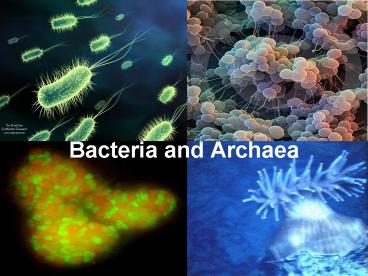Bacteria and Archaea - PowerPoint PPT Presentation
1 / 20
Title:
Bacteria and Archaea
Description:
Cleaning Up Bioremediation 5. Making Medicines 4. In Your Food ... Sac Fungi 2. Club Fungi 1. Threadlike Fungi Club Fungi Threadlike Fungi 3 Main Types of Fungi ... – PowerPoint PPT presentation
Number of Views:273
Avg rating:3.0/5.0
Title: Bacteria and Archaea
1
Bacteria and Archaea
2
Shapes of Bacteria
- Rod shaped
Bacilli
- Spherical shaped
Cocci
Spirilla
- Spiral shaped and long
3
Characteristics of Bacteria and Archaea
- Prokaryote (No nucleus)
- Binary fission
4
- Thick wall
Endospore
- Contains genetic material
- Can remain dormant
- Reactivates when living conditions improve
Bacteria Domain
- More organisms than other domains combined
- Each classified by method of obtaining food
- Most are consumers
5
Cyanobacteria
- Producers
- Usually live in water
- Contain chlorophyll
Archaea Domain
- Live in extreme environments
- Live in little to no oxygen
6
Good for Environment
- Convert Nitrogen from the air
1. Nitrogen Fixation
- Changes into forms plants can use
- Decomposers
2. Recycling
- Break down dead organisms
7
- Changes harmful substances to harmless
3. Cleaning Up
- Using microorganisms
Bioremediation
- Cleans waste or oil spills
- Some foods require bacteria
4. In Your Food
Ex yogurt, cheese, bread
- Some bacteria used to make medicines
5. Making Medicines
- Make antibiotics
- Medicine used to kill bacteria
Antibiotic
8
Harmful Effects
- Causes disease
Pathogenetic
- Take nutrients from host cell
9
Viruses
10
- Very tiny
- Non-living
- Contain DNA
- Classified by their shape
- Invade hosts
- Use Lytic Cycle for reproduction
- Can stay inactive for long periods of time
4 Main Shapes
1. Crystals
2. Spheres
3. Cylinders
4. Spacecraft
11
(No Transcript)
12
(No Transcript)
13
- Antibiotics dont kill viruses
- No cures for viruses
- Best defense is prevention
14
Protists and Fungi
15
Protists
- Complex single-celled organisms
- Do not form tissues or organs
- Can obtain food in different ways
- Feeds on a living organism
Parasite
- Usually harmful
Host
- Organism that a parasite feeds off of
3 Types
1. Producers
2. Heterotrophs that can move
3. Heterotrophs that can not move
16
Producer Protists
- Plant-like
- Undergo photosynthesis
Ex Algae (aka Seaweed)
Heterotrophs That Can Move
- Animal-like
- Also called Protozoans
- Eat other organisms
Ex Amoeba
Pseudopodia
- False feet
- Cell stretches membrane
17
Heterotrophs That Can Not Move
- Most are parasitic
- Some can move in certain phases of their life
- Some produce spores
Fungi
- Decomposers
- Contain cell walls
- Made of chains of cells
18
- Thread-like strings of fungus cells
Hyphae
- Cluster of hyphae
Mycelium
- Grows underground
- Fungus reproductive structure
Spores
- Light enough for the wind to carry
19
3 Main Types of Fungi
1. Threadlike Fungi
2. Club Fungi
3. Sac Fungi
- Bread mold
Threadlike Fungi
- Looks stringy
Club Fungi
- Mushrooms
- Grows on soil or trees
Basidia
- Umbrella-shaped structure
- Contain spores
20
Sac Fungi
- Yeast, Mildew
- Largest group of fungi
- Some reproduce by budding
- Sac grows off the parent cell
Budding
Yeast
- Produces carbon dioxide as a waste
- Useful in foods and drinks
Lichen
- Combination of fungus and algae
- Live in a symbiotic relationship
Symbiosis
- Relationship where both organisms benefit































